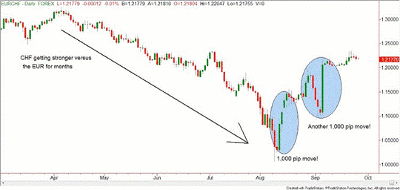Part 2 of this multi-part series explores the impact of quantitative easing programs on currencies and their underlying economies, using recent actions in the US and Eurozone as examples.
In yesterday’s article, we were discussing one way a government or central bank may influence the strength of their currency, which was by lowering interest rates. When a local currency has a lower rate than a foreign currency, the foreign currency will draw more investment dollars than the local currency, thereby helping to keep the local currency weak to help the local economy.
But what happens when both currencies have an extremely low rate? What else can a government do to weaken its currency?
One interesting technique is called "quantitative easing," or QE. This rather vague term refers to the act of a central bank buying financial assets of banks and other private-sector businesses with money that is essentially created electronically (printing money).
This action raises the prices of those particular assets (temporarily) and lowers their yield. All else being equal, anytime you increase the supply of something, you lower its value according to Economics 101.
This is even true when talking about a currency. If more dollars are printed, the actual value (purchasing power) of those dollars is decreased. Commonly, this is called inflation.
Think about it like this: in the 1960’s, someone making $100,000 a year could buy a couple of houses, cars, and live like a king with money left over. Today, someone making that much per year would certainly not live at such a level of extravagance.
What changed? Not the number of dollars made per year, but the value of those individual dollars.
So, what happens with all of that quantitative easing money that is spent by a central bank? Their stated objective is to have the private banks/businesses who receive this money invest the money in local business by lending out money, perhaps hiring more employees, etc.
However, just because you create the money and give it to someone else in exchange for some junk on their balance sheet does not mean you have control of this money once it is in a private bank’s hands.
Occasionally, a private bank may actually use this money to (gasp!) speculate in different markets; stocks, precious metals, energy commodities, whatever. Do these actions stimulate the local economies, as intended by the central banks? Hardly.
When a central bank prints $100 in new currency, no one notices. But when a central bank does numerous rounds of quantitative easing totaling hundreds of billions, or even trillions of dollars, it becomes very noticeable!
See related: Central Banking 101 for Forex Traders
This increased supply of dollars has caused each dollar’s value to decrease. While I understand the stated inflation rate of approximately 3.8% doesn’t seem very high, most people will realize that their weekly trips to the grocery store are much more than 3.8% higher than a year ago.
Some calculations of inflation that are no longer in favor by certain governments show inflation at two to three times higher than what they currently report. If your income isn’t growing at the same rate, you are actually earning less than you were last year. That sounds a bit more familiar, now doesn’t it?
As a reminder, a central bank of a government or economy does want a somewhat weaker currency so as to stimulate the local economy, but when every government is in a competition to have the weakest currency, eventually their battles trickle down to affect the normal person on the street, and as we have seen recently, that effect has been somewhat negative.
Yet another way a central bank/government can intervene in their currencies strength is to go out into the forex market and actually sell their currency. While a central bank will have more tools at their disposal than the casual retail trader—including trading in the spot, futures, options, and volatility swap markets—the profound effect on the currency market will still be noticeable.
Japan’s central bank has done this numerous times. Their effectiveness at intervening has been limited, at best, however, the very recent Swiss National Bank interventions have had a much more dramatic and lasting effect.
Over the past few weeks, the Swiss franc (CHF) has had two 1,000-pip moves in the EUR/CHF currency pair. The USD/CHF has had impressive moves as well. The reason I chose to show the EUR/CHF is to demonstrate that every central bank is affecting everyone else, no matter the cost.
See related: Intro to Trading the Swiss Franc
There is much discussion we could have about free market economics and how capitalism has helped/destroyed the world over the past several years. My personal belief is that we haven’t had true capitalism for nearly 100 years, so no one alive has been able to experience it firsthand in a business setting anyway.
Everyone who complains that capitalism is destroying us is misinformed. We don’t have true capitalism. Will we revert back to true 100% capitalism in our economies and markets? In my opinion, no. The central banks and their structures are too entrenched in governments and societies to expect them to disappear whether we like it or not. That doesn’t mean all hope is lost!
Being able to supplement or replace your income by applying your trading knowledge is one way we can help to level the playing field. Get yourself to an Online Trading Academy workshop, enroll in one of our classes, read these articles on MoneyShow.com, sign up for the extended learning track (XLT) program, or attend a Traders Expo!
Educate yourselves and you can look with confidence into the future of our economy instead of fear!
By Rick Wright, instructor, Online Trading Academy






















